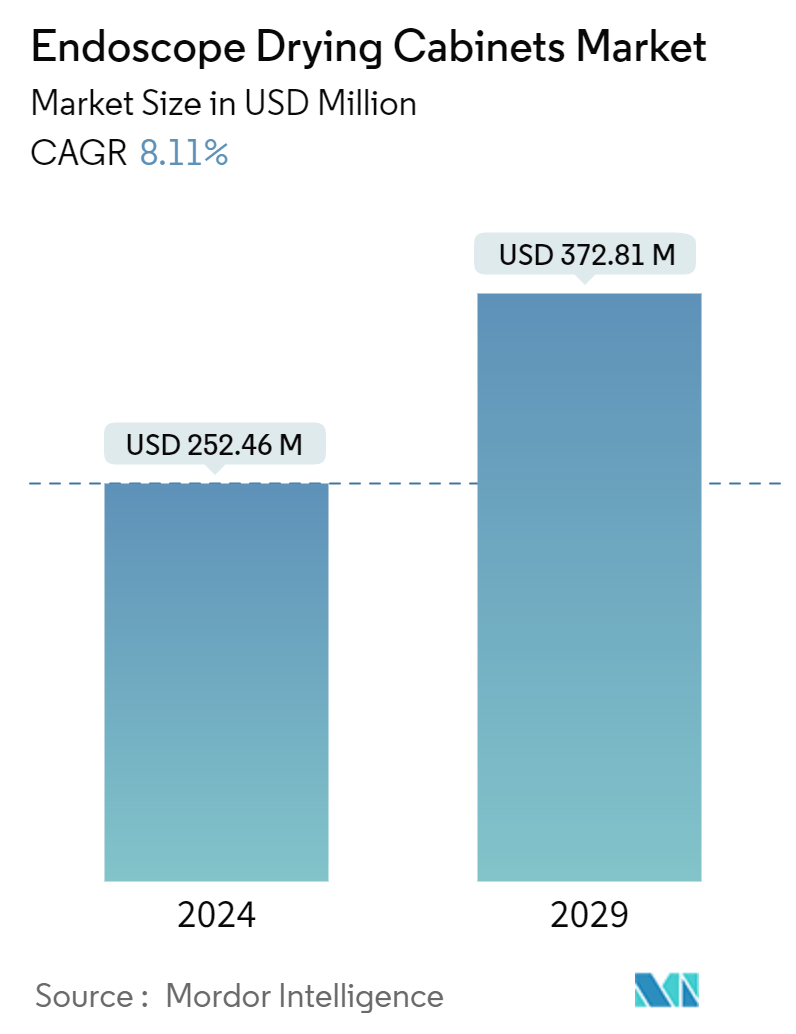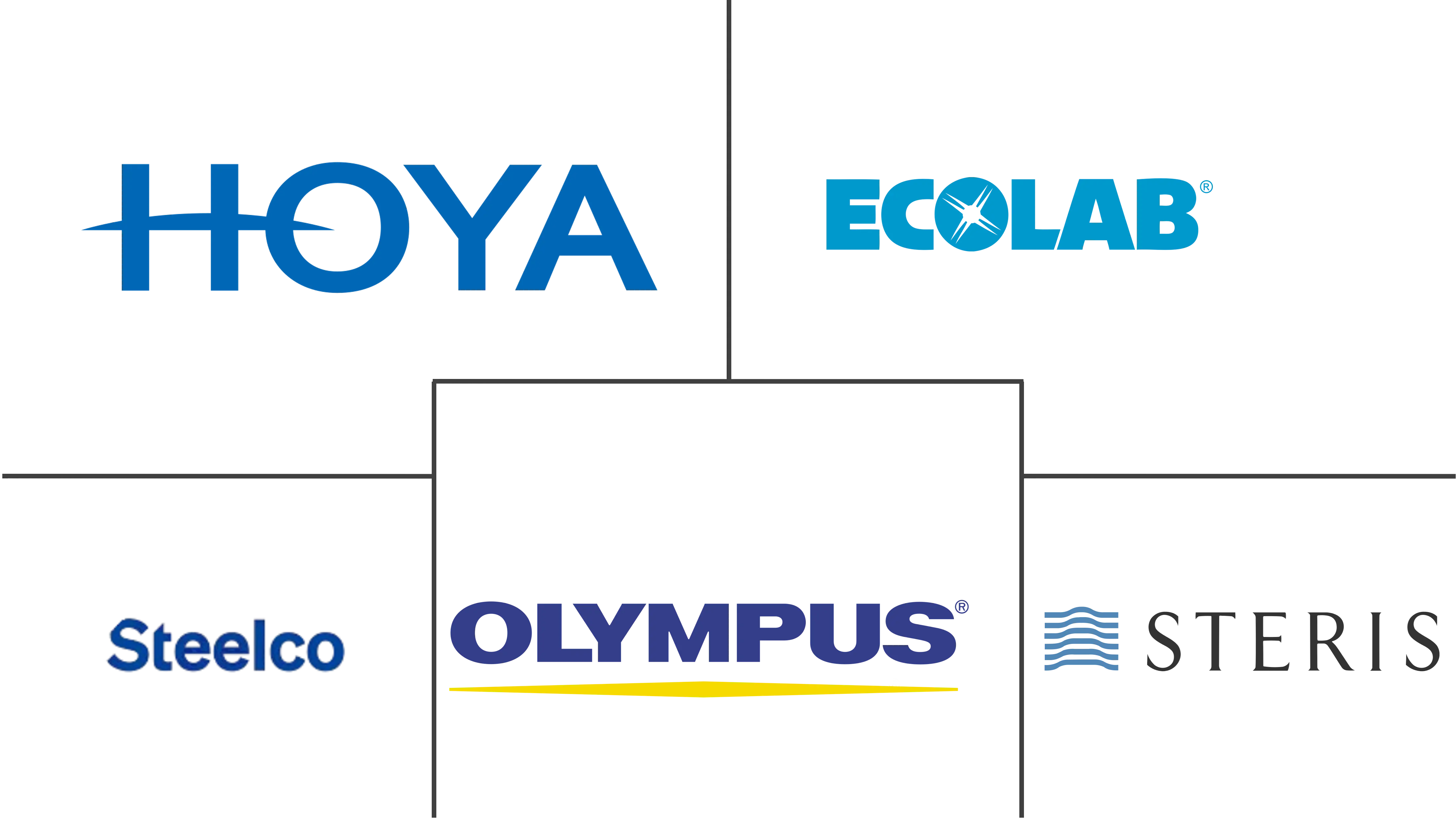Market Size of Endoscope Drying Cabinets Industry

| Study Period | 2019 - 2029 |
| Market Size (2024) | USD 252.46 Million |
| Market Size (2029) | USD 372.81 Million |
| CAGR (2024 - 2029) | 8.11 % |
| Fastest Growing Market | Asia Pacific |
| Largest Market | North America |
| Market Concentration | Medium |
Major Players
*Disclaimer: Major Players sorted in no particular order |
Endoscope Drying Cabinets Market Analysis
The Endoscope Drying Cabinets Market size is estimated at USD 252.46 million in 2024, and is expected to reach USD 372.81 million by 2029, at a CAGR of 8.11% during the forecast period (2024-2029).
Factors such as the increasing number of surgical procedures, rising burden of chronic diseases, and growing awareness of infection control, coupled with the rising burden for reusable endoscopes and technological advancements in cabinets, are expected to boost the growth of the endoscope drying cabinets market over the forecast period.
The rising burden of chronic diseases such as cancer, gastrointestinal disorders, and obesity is a key factor propelling market growth as people with cancer and obesity require frequent endoscopic evaluations and interventions, thus bolstering the need for effective sterilization and drying processes for endoscopes. This is anticipated to fuel the demand for reliable drying cabinets over the coming years, thus driving market growth.
For instance, a May 2023 study published in BMC Medical Research projected that by 2030, around 7 million individuals in Europe and the United States would be living with inflammatory bowel disease (IBD). Additionally, IBD prevalence is expected to surpass 0.3% in regions like North America, Oceania, and parts of Europe by 2030. This anticipated rise in lower gastrointestinal tract diseases, notably IBD, is set to boost the demand for endoscopes used in diagnosis and treatment. As healthcare facilities focus on infection control and the upkeep of endoscopic instruments, the demand for efficient endoscope drying cabinets is likely to rise, further fueling market growth.
Furthermore, reports of endoscope contamination are on the rise, underscoring the urgent need for rigorous infection control in healthcare environments. For instance, a June 2023 article published in Microbiology Spectrum highlighted a troubling trend where Tehran, Iran, was witnessing a surge in outbreaks linked to contaminated gastrointestinal (GI) endoscopes. It further highlighted that GI flora was the predominant contaminant on GI endoscopes, with key bacteria identified as Pseudomonas aeruginosa, Escherichia coli, and Klebsiella pneumonia. The research revealed an unexpectedly high contamination rate on reprocessed GI endoscopes, ready for patient use, indicating an elevated risk for endoscopy-associated infections (EAI). Such notable incidents have heightened awareness regarding the critical nature of thorough cleaning, disinfection, and drying of endoscopes, suggesting a strong potential for market growth for endoscope drying cabinets in the coming years.
Healthcare facilities are increasingly prioritizing infection control to mitigate endoscope contamination. This heightened focus is expected to drive the demand for specialized cabinets designed for drying endoscopes. Also, government entities and hospitals are placing a strong emphasis on reprocessing endoscopes. For instance, the Hospital Infection Control 2024 Manual, published by the All India Institute of Medical Science, mandates that endoscopes undergo a thorough reprocessing regimen. This includes cleaning and disinfecting with a high-level disinfectant, rinsing to eliminate any disinfectant residue, and finally, drying and storing them in specialized drying cabinets to minimize recontamination risks. Such endorsements are poised to boost the adoption of endoscope drying cabinets, further fueling market growth.
Therefore, owing to the increasing number of gastrointestinal diseases and rising cases of endoscope infection, coupled with the growing initiatives of the government and hospitals for infection control, the market studied is expected to grow over the forecast period. However, the high cost of endoscopy procedures and the lack of skilled professionals are likely to restrain market growth over the forecast period.

